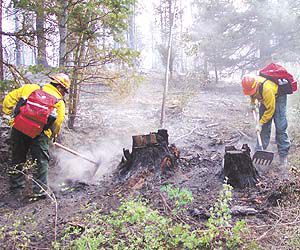| Firemen work to put out a fire on Nelson Mountain a couple of years ago. |
As we watch the television images of raging fires engulfing homes and property in Southern California, the thoughts of are we prepared if that were to happen here enters our consciousness. The public should know that there are those dedicated people out there who are considering that possibility on a statewide basis.
In a collaborative effort, the Bureau of Land Management, the US Forest Service, the Utah State Fire, Forestry and State Lands, local county governments and community members are preparing a plan for just that event. Emily Geery, a watershed and wildland fire planner said, “We have been meeting since July to gather information from the public and the management agencies to find and identify the areas of concern. We want to solicit information from the local people on what areas they want protected the most.”
At the Museum of the San Rafael, these agencies came together for an regional comment gathering meeting. Armed with information about the plans that are already in place, they waited for the public to add their own concerns. Utah is divided into five fire districts, and Emery County is grouped with Carbon, Grand and San Juan counties in this region.
Geery stated that Emery County is very well prepared as they have a plan in place already. The regional plan will address a lot of the same issues and will rely on Emery County’s plan. Emery County has identified the areas of concern for wildland fire and have also identified resources to fight a fire should it occur in one of these areas of concern.
For homeowners in the areas of concern, there are many recommendations for them as property owners. The area already identified in Emery County is the Joe’s Valley area. With two housing areas near Joe’s Valley, the wildland interface and the danger of fire is a great concern. Should a fire start in this area, the plan is moving to meets its goal of educating all property owners in the area.
Some suggestions are to clean roof surfaces and gutters of pine needles, leaves, branches, etc. regularly to avoid accumulation of flammable materials. Remove portions of any tree extending within 10 feet of the flue opening of any stove or chimney. Maintain a screen constructed of nonflammable material over the flue opening of every chimney or stovepipe. Openings in the screen should not exceed one half inch.
Remove branches of surrounding trees to a height of 15 feet. Dispose of stove or fireplace ashes and charcoal briquettes only after soaking them in a metal pail of water. Store gasoline in an approved safety can away from occupied buildings. Propane tanks should be far enough away from buildings for valves to be shut off in case of fire.
Keep area clear of flammable vegetation. All combustibles, such as firewood, picnic tables, boats, etc. should be kept away from structures. Garden hoses should be available for connection to a water outlet. Addressing should indicated at all intersections and on structures. All roads and driveways should be at least 16 feet in width. Fire tools such as a ladder long enough to reach the rood, shovels, rakes, and buckets should be readily available. Each home should have at least two different entrance and exit routes.
Along with these suggestions, there are many other ways to keep a property safe. One is to use firewise landscaping with firewise plants. A list of these plants can be found at www.firewise.org.
Once a group of property owners comes together to make a plan, the group can apply for a number of grants to help reach the goals of the plan. In this area the fire warden is Rudy Sandoval and he can help supply property owners with information about any of the suggestions for making your property firewise.
Concerns about this area and its fire readiness can be sent to Southeastern Utah RWPP, 5647 Jefferson Street NE, Albuquerque, N.M. 87109. If a person wants to comment, they should include the area where they live and their contact information, their opinions about what actions could be taken to reduce the threat of wildfire, where is the greatest need, a list of the structures and things of value in the area, what should the fire emergency service agencies and personnel know about your properties, what information do property owners need to know to be prepared, and what is the single most important action that could be taken to reduce the threat of wildfire in the southeast region and your county.
When a person sends their comments, note on the comment sheet that these comments are concerning the Carbon/Emery wildland fire mobilization plan.

